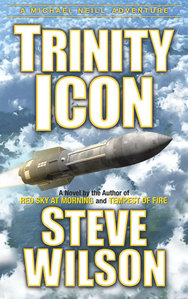
Reviewed for Readers' Favorite at www.ReadersFavorite.com.
* * * * *
I have now had the pleasure of reading Trinity Icon, the third installment of Steve Wilson’s Michael Neill Adventures. The story opens with a tale from days long gone, when the Swedes invaded Poland. The story of the Swedes’ raid is passed through the ages, as survivors’ descendents continue to search for an icon missing from the church where Father Jakob was murdered on a snowy Christmas Eve in 1655. The story then picks up with Marine Captain Michael Neill. This time Neill is required to assist with events unfolding in Poland—events that include the antics of the Russians. Meanwhile, assassins pursue the lovely journalist, Viktoriya Gavrilenko, whom Neill met some time previously in Odessa, Russia. Viktoriya follows the story of the missing icon—a mystery that may finally be resolved, as an archeologist has found the sunken and long lost Swedish vessel on which he hopes the icon rests. Neill and others, including his love-interest, Marine Staff Sergeant Christina Arrens, seek to protect Viktoriya. At the same time, they endeavor to get the leaders of the surrounding countries to join together in opposition to Russia’s bully tactics. Throughout the tale, Wilson takes readers on a tour of beautiful and historic city and countryside venues in Poland and along the way, clues to the events of that dreadful murder in 1655 are revealed and the mystery of those days long gone, is ultimately solved.
I spent some time thinking about what I found most enjoyable about Steve Wilson’s Trinity Icon. I will identify the most notable points. First, I sincerely appreciate reading a work like this, which draws on my understanding of history and politics. The tale, with its frequent use of those “musical” Russian names, stirred my memories of long ago days, when I studied so much Russian history, politics and philosophy. Wilson has a thorough understanding of these things. For the well-versed, it makes for an enjoyable read. But even the lesser-informed reader could enjoy these tales—and learn something in the process. Second, I appreciate Wilson’s expertise regarding the military as an organization, and the weapons and tools (including aircraft) at their disposal. A reader is sure to gain some knowledge in these areas. (This one certainly did.) Third, it is rare to find a “leading man” of such authority and integrity as Michael Neill. At times, he seems almost unreal, as so few such men seem to exist today. But is that not the point of a great tale—to inspire and to challenge? Trinity Icon most certainly does so. Finally, I quite enjoyed the give and take between Neill and Arrens and those little touches that could only be dubbed “romance.” While military rules prohibit certain relationships, the story reveals their true affection for one another. This reader expects they will make decisions in the stories to come, such that they may fully entertain their feelings. But for now, this reader also is delighted to know that honorable men and women, though rare, do still exist.
* * * * *
I have now had the pleasure of reading Trinity Icon, the third installment of Steve Wilson’s Michael Neill Adventures. The story opens with a tale from days long gone, when the Swedes invaded Poland. The story of the Swedes’ raid is passed through the ages, as survivors’ descendents continue to search for an icon missing from the church where Father Jakob was murdered on a snowy Christmas Eve in 1655. The story then picks up with Marine Captain Michael Neill. This time Neill is required to assist with events unfolding in Poland—events that include the antics of the Russians. Meanwhile, assassins pursue the lovely journalist, Viktoriya Gavrilenko, whom Neill met some time previously in Odessa, Russia. Viktoriya follows the story of the missing icon—a mystery that may finally be resolved, as an archeologist has found the sunken and long lost Swedish vessel on which he hopes the icon rests. Neill and others, including his love-interest, Marine Staff Sergeant Christina Arrens, seek to protect Viktoriya. At the same time, they endeavor to get the leaders of the surrounding countries to join together in opposition to Russia’s bully tactics. Throughout the tale, Wilson takes readers on a tour of beautiful and historic city and countryside venues in Poland and along the way, clues to the events of that dreadful murder in 1655 are revealed and the mystery of those days long gone, is ultimately solved.
I spent some time thinking about what I found most enjoyable about Steve Wilson’s Trinity Icon. I will identify the most notable points. First, I sincerely appreciate reading a work like this, which draws on my understanding of history and politics. The tale, with its frequent use of those “musical” Russian names, stirred my memories of long ago days, when I studied so much Russian history, politics and philosophy. Wilson has a thorough understanding of these things. For the well-versed, it makes for an enjoyable read. But even the lesser-informed reader could enjoy these tales—and learn something in the process. Second, I appreciate Wilson’s expertise regarding the military as an organization, and the weapons and tools (including aircraft) at their disposal. A reader is sure to gain some knowledge in these areas. (This one certainly did.) Third, it is rare to find a “leading man” of such authority and integrity as Michael Neill. At times, he seems almost unreal, as so few such men seem to exist today. But is that not the point of a great tale—to inspire and to challenge? Trinity Icon most certainly does so. Finally, I quite enjoyed the give and take between Neill and Arrens and those little touches that could only be dubbed “romance.” While military rules prohibit certain relationships, the story reveals their true affection for one another. This reader expects they will make decisions in the stories to come, such that they may fully entertain their feelings. But for now, this reader also is delighted to know that honorable men and women, though rare, do still exist.


